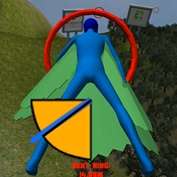Virtual Reality software brings hope to stroke survivors

Games Technology students and Computer Science lecturers from Murdoch's School of Engineering and Information Technology are helping stroke survivors put their lives back together.
The team from Murdoch has worked with clinicians from the West Australian Neuroscience Research Institute (WANRI) to develop a computer-based Virtual Reality (VR) rehabilitation program called Neuromender, which will greatly advance the recovery of stroke survivors.
The Neuromender software captures detailed upper body data in real-time as survivors fly a 'wing-man' through a virtual world, with the task difficulty levels adjusted automatically by the system.
"Neuromender is a low-cost computer-based system that enables users to interact with a multisensory simulated environment in the comfort and convenience of their own home," said Senior Lecturer and Project Leader Dr Mohd Fairuz Shiratuddin.
Stroke is the number one cause of long-term disability in adults in Australia, effecting more than 50,000 Australians each year.
Currently within Australia, there are no established evidence-based VR rehabilitation programs with detailed, high resolution monitoring for the neurorehabilitation of the upper limb of stroke survivors.
As survivors use the Neuromender System, data is sent to the Neuromender's central server, where survivors' progress can be assessed online by Clinicians.
"Clinicians assign rehabilitative tasks to stroke survivors in their care. These tasks can be performed using any recent off the shelf sub $700 personal computer. The tasks have been specifically designed to be engaging and system is adaptive to keep the survivors' motivation levels high," said Shri Rai, Academic Chair of Computer Science and Games Technology.
Up to 75 per cent of stroke survivors continue to experience motor deficits associated with reduced quality of life, either as a direct result of the stroke itself or longer-term effects of disuse, inactivity and/or lifestyle changes after stroke.
"Hand and arm weakness is a common problem following stroke that substantially impacts on the quality of life of stroke survivors," said Associate Professor Michelle Byrnes from WANRI.
"This VR rehabilitation program will have immense, positive, long-term implications for the upper rehabilitation and recovery of stroke survivors in the future."
The motivation for developing an economical software system that could assist the rehabilitation of stroke survivors came from Dr Shiratuddin, whose mother is a stroke survivor.
"Neuromender is designed to be extensible, and will be expanded to include more interactive and engaging contents in the near future," he said.
A pilot trial is set to begin in the summer of 2016 featuring 20 stroke survivors.

















